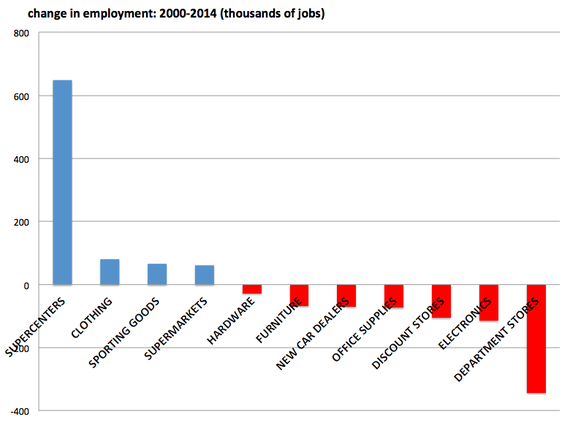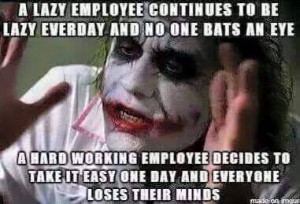No Rest for the Working, Why Retail Hours Suck

On the nights when she has just seven hours between shifts at a Taco Bell in Tampa, Fla., Shetara Brown drops off her three young children with her mother. After work, she catches a bus to her apartment, takes a shower to wash off the grease and sleeps three and a half hours before getting back on the bus to return to her job.
At Hudson County Community College in Jersey City, Ramsey Montanez struggles to stay alert on the mornings that he returns to his security guard station at 7 a.m., after wrapping up a 16-hour double shift at 11 p.m. the night before.
And on many Friday nights, Jeremy Little waits tables at a Perkins Restaurant & Bakery near Minneapolis and doesn’t climb into bed until 3 a.m. He returns by 10 a.m. for the breakfast rush, and sometimes feels so weary that he forgets to take rolls to some tables or to tell the chef whether customers wanted their steak medium rare.
“It makes me feel really tired,” Mr. Little said. “My body just aches.”
Employees are literally losing sleep as restaurants, retailers and many other businesses shrink the intervals between shifts and rely on smaller, leaner staffs to shave costs. These scheduling practices can take a toll on employees who have to squeeze commuting, family duties and sleep into fewer hours between shifts. The growing practice of the same workers closing the doors at night and returning to open them in the morning even has its own name: “clopening.”

“It’s very difficult for people to work these schedules, especially if they have other responsibilities,” said Susan J. Lambert, an expert on work-life issues and a professor of organizational theory at the University of Chicago. “This particular form of scheduling — not enough rest time between shifts — is particularly harmful.”
The United States decades ago moved away from the standard 9-to-5 job as the manufacturing economy gave way to one dominated by the service sector. And as businesses strive to serve consumers better by staying open late or round the clock, they are demanding more flexibility from employees in scheduling their hours, often assigning them to ever-changing shifts.
Workers and labor advocates are increasingly protesting these scheduling practices, which often include giving workers as little as two days’ advance notice for their weekly work schedule. These concerns have gained traction and translated into legislative proposals in several states, with proponents enviously pointing to the standard adopted for workers in the 28-nation European Union. It establishes “a minimum daily rest period of 11 consecutive hours per 24-hour period.”
Britain, Germany and several other countries interpret that to require that workers be given at least 11 hours between shifts, although waivers are permitted. “If a retail shop closes at midnight, the night-shift employees are not allowed to start before 11 o’clock the next morning,” said Gerhard Bosch, a sociology professor and expert on labor practices at the University of Duisburg-Essen in Germany.
In the United States, no such national or state labor law or regulation governs the intervals between shifts, except for some particular jobs like airline pilots, although some unions have negotiated a minimum time for workers to be off, sometimes eight, 10 or 12 hours.
But at the state level this year, bills have been introduced in Maryland and Massachusetts and will be introduced in Minnesota on Monday, each of them calling on employers to give workers at least 11 hours between shifts and three weeks’ advance notice for schedules. Those proposals would require businesses to pay some time and a half whenever employees are called in before 11 hours have passed between shifts.
Paul Thissen, the Democratic leader of the Minnesota House of Representatives, supports the legislation. “When it comes to scheduling, the playing field is tilted very dramatically in favor of the employer,” Mr. Thissen said. “What we’re proposing is just trying to rebalance the playing field.”
Anthony Newby, executive director at Neighborhoods Organizing for Change, a Minneapolis-based group that advocates for worker rights, among other issues, said that clopenings have become a big issue in his region. “Clopenings are hurting many of our members; many are in the restaurant field and some in construction and nursing,” he said. “We worry it has an effect on safety — workers feel they’re on autopilot. It also has a big impact on families, on mothers trying to manage a family and arrange child care.”
Ms. Brown, who works as a cashier at Taco Bell, said her children — ages 5, 4 and 2 — don’t like it when she has just seven hours between shifts. That usually means they hardly see her for two nights in a row; they sleep at their grandmother’s both nights. On the second night, after just three and a half hours’ sleep the previous day, Ms. Brown says she stops by her mother’s for an hour or two to see her children, and then heads home to sleep.
“My kids say, ‘Mommy, I miss you,’ ” she said. “I get so tired it’s hard to function. I feel so exhausted. I don’t want my kids suffering not seeing me. I try to push to go see them.”
Although Ms. Brown dislikes clopenings, she doesn’t turn them down because she needs as many hours as she can get. She makes $8.10 an hour and works about 25 hours a week.
Brandon Wagner, who works for a Zara apparel store in Manhattan, often works from 1 p.m. until 10:30 p.m. or 11 p.m., getting back to his apartment in Brooklyn around midnight. He often must be back at work at 8 the next morning, and as a result he sleeps just five hours.
“When you question this, they give a shrug of the shoulder,” Mr. Wagner said. “They say, ‘Everybody does this. You have to put up with it or go somewhere else.’ ”
Last summer, Starbucks announced that it would curb clopenings on the same day that The New York Times published an article profiling a barista, Jannette Navarro, mother of a 4-year-old, who worked a scheduled shift that ended at 11 p.m. and began a new shift at 4 a.m.
At the time, Cliff Burrows, Starbucks’s group president for the United States, said: “Partners should never be required to work an opening and a closing shift back-to-back. District managers must help store managers problem-solve issues specific to individual stores to make this happen.” (“Partners” is the term Starbucks uses for its employees.)
Neil Trautwein, a vice president with the National Retail Federation, acknowledged that some instances of scheduling were egregious, but he pointed to Starbucks’s voluntary response to argue that states should not enact any laws to address the issue.
“Advocates have it wrong to think you can legislate and just outlaw the process,” Mr. Trautwein said. “The market adjusts to the needs of workers.” He added that what Starbucks did “demonstrates that businesses listen to their employees and adjust.” (In response to complaints about schedules changing week to week, Walmart said on Thursday that it would give workers more predictable schedules.)
But several people who identified themselves as Starbucks employees complained on a Facebook private group page that they still were scheduled for clopenings, despite the company’s pronouncement. One worker in Texas wrote on Jan. 30, “I work every other Sunday as a closer, which is at 10:30 or really 11-ish, then scheduled at 6 a.m. the next morning.” Another worker in Southern California wrote, “As a matter of fact I clopen this weekend.”
Laurel Harper, a Starbucks spokeswoman, questioned the authenticity of the Facebook posts. She said company officials had held conversations nationwide “to make sure we are giving our partners the hours they want” and to prevent clopenings.
Some managers say there are workers who don’t mind clopenings — like students who have classes Monday through Friday and want to cram in a lot of weekend work hours to maximize their pay.
Tightly scheduled shifts seem to have become more common for a number of reasons. Many fast-food restaurants and other service businesses have high employee turnover, and as a result they are often left with only a few trusted workers who have the authority and experience to close at night and open in the morning. Professor Lambert said no studies had been done on the prevalence of clopenings nationwide.
Carrie Gleason, director of the fair workweek initiative at the Center for Popular Democracy, a liberal advocacy group, said one reason for the increasing prevalence of clopenings was that many companies had shifted scheduling responsibilities away from managers and to sophisticated software that she said was not programmed to prevent such short windows between shifts.
But David Ossip, chief executive of Ceridian, a human resources and payroll company, said that when his company provided scheduling software to companies, it generally recommended programming a mandated rest period. The software would then warn managers when an added shift violated that rest period.
“You would make sure you have a minimum rest period between shifts,” he said. “We would set up fairness results that call for regular working hours — not one day work at night, the next day work in the morning.” He added, “You have to be home for eight, 10 or 12 hours.”
Andy Iversen, a stocker at Linden Hills Co-op in Minneapolis, said the grocery store’s managers used to schedule him two or three times a week to work until 9 p.m., and then be back at 5 a.m.
“I was beyond exhausted,” he said, noting that he was getting to bed at midnight and waking around 3:45 a.m. At the time, he was pursuing a master’s degree and taking a course in neuroscience. “I couldn’t concentrate because I was so tired,” he said. “I had to drop out of class.”
Mr. Iversen praised his store’s managers for no longer giving him clopenings. Marshall Wright, the store’s produce manager, said, “We think it’s the right thing to do. We don’t feel people should work shifts like that.”
Mr. Iversen couldn’t agree more: “It doesn’t take that much empathy or reasoning to see that clopenings stink, and people don’t want to do it.”
Sourced from nytimes.com



























Recent Comments